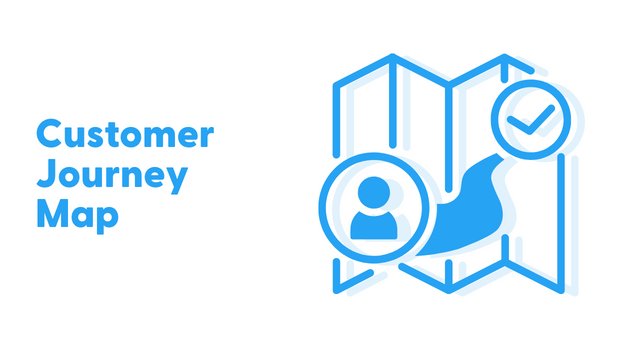A customer journey map represents a customer’s experiences when interacting with a company, from initial awareness of a product or service to post-purchase evaluation. It is typically created to help a company understand and improve the customer experience. This includes identifying key touchpoints, pain points, and opportunities for improvement.
Customer journey mapping is important because it helps companies understand their customers’ needs, wants, and expectations. It allows them to see the customer experience from the customer’s perspective and identify areas where they can improve their products, services, and overall customer experience. Additionally, it can help companies identify key moments of truth, which are critical touchpoints in the customer journey that can significantly impact customer satisfaction and loyalty. By optimizing these touchpoints, companies can increase customer retention, reduce churn, and drive growth.
Types of Customer Journey Map
There are several types of customer journey maps, each with its own unique characteristics and uses. Some common types include:
- Empathy Maps: These maps focus on understanding the customer’s feelings, thoughts, and actions throughout their journey. They are often used to identify pain points and opportunities for improvement. Example: A mobile phone company creating an empathy map for customers who are experiencing dropped calls.
- Process Maps: These maps focus on the specific steps a customer takes during their journey, such as navigating a website or making a purchase. They are often used to identify bottlenecks and inefficiencies in processes. Example: A retail company creating a process map for customers purchasing online.
- Service Blueprint: This map combines both the customer’s perspective and the company’s internal processes. It is often used to identify areas where the customer experience can be improved and where internal processes can be streamlined. Example: A bank creating a service blueprint for customers opening a new account.
- Value Proposition Maps: This type of map focuses on the value that a product or service provides to the customer and how it meets their needs. Example: A eCommerce company creating a value proposition map for customers looking for sustainable products
- Touchpoints Map: is a visual representation of the various touchpoints or interactions a customer has with a company or brand throughout their journey. It shows the different channels and mediums (such as email, phone, website, in-store, etc.) that customers use to interact with the company, and how these touchpoints connect and influence the customer’s overall experience. This map helps to understand and identify friction points and opportunities to improve the customer experience.
- Experience Map: This type of map is more holistic and focuses on the customer’s overall experience. They often identify areas where the customer experience can be improved and where internal processes can be streamlined. Example: A hotel creates an experience map for guests staying at the hotel.
Overall, different types of customer journey maps serve different purposes, and the choice of which one to use will depend on the specific goals and objectives of the project.
Also, read:
Creating a Customer Journey Map
You can follow these steps to create a customer journey map:
- Identify the stages of the customer journey: The stages of the customer journey can vary depending on the product or service offered and the customer’s individual experience.
- Determine the touchpoints: These are the contact points that a customer has with a company during the journey, such as visiting a website, interacting with customer service, or using a product. Read more: Customer Data Platform.
- Identify the emotions and needs of the customer at each stage: What is the customer feeling and thinking at each stage of the journey, and what are their needs and goals?
A customer’s emotions and needs can change at different customer journey stages. For example, a customer may start out excited about a new product, but their emotions and needs may shift as they use it. - Map out the journey: Use a visual representation to show the stages of the journey and the touchpoints, as well as the emotions and needs of the customer at each stage.
Different tools and platforms can be used to map the customer journey. Some common options include:- Customer journey mapping software: Several specialized software tools can be used to create visual diagrams or maps of the customer journey. These tools typically allow users to add different stages or touchpoints in the journey, and to include information about the customer’s emotions, needs, and behaviors at each stage.
- Project management tools: Tools such as Asana, Trello, and Monday.com can be used to create customer journey maps by creating a series of tasks or “cards” that represent each stage of the journey. These tools can also be used to track progress, add notes and comments, and collaborate with team members.
- Spreadsheets: Simple spreadsheet programs such as Microsoft Excel or Google Sheets can be used to create basic customer journey maps by creating rows for each journey stage and columns for different pieces of information, such as the customer’s emotions, needs, and behaviors.
- Identify Opportunities for Improvement: Look for areas where the customer experience could be enhanced, such as by streamlining processes or adding additional touchpoints.
- Test and Iterate: Use customer feedback and data to refine and improve the journey map over time.
Benefits of Mapping Customer Journey
Mapping the customer journey can help a company understand and improve the customer experience in several ways:
- Identify pain points and opportunities for improvement: By understanding the customer’s needs and emotions at each stage of the journey, a company can identify areas where the customer is experiencing frustration or difficulty, and work to address those issues.
- Improve customer satisfaction: A company can increase customer satisfaction and loyalty by addressing pain points and improving the customer experience.
- Increase sales and revenue: By improving the customer experience, a company may be able to increase sales and revenue through increased customer loyalty and word-of-mouth advertising.
- Enhance the effectiveness of marketing efforts: By understanding the customer journey, a company can better target its marketing efforts and create more effective campaigns.
- Increase efficiency: A company can streamline its processes and save time and resources by identifying and addressing bottlenecks or inefficiencies in the customer journey.
Proper customer journey mapping can help a company better understand and serve its customers, leading to increased satisfaction, loyalty, and business success.
Here are a few real-life examples of how companies can use customer journey mapping to increase revenue:
Type of Business |
Identified Gaps |
Opportunity |
| Retail store | Long lines at checkout, difficulty finding products | Improve customer experience, increase likelihood of repeat purchases |
| eCommerce company | Unoptimized online shopping experience, inefficient checkout process | Streamline checkout process, offer personalized product recommendations to improve customer experience |
| Hotel chain | Missed opportunities to upsell services during customer’s stay | Identify key points for upselling services, such as offering room upgrades or spa packages |
| Software company | Poor onboarding experience for new users | Improve onboarding experience, increase customer retention and upgrades to paid plans |
| Subscription-based service | Difficulty in encouraging customers to renew or upgrade their subscription | Identify ways to encourage renewals and upgrades, improve customer experience to retain customers |
Five Best Practices to Consider when Creating a Customer Journey Map
- Involve stakeholders: Make sure to involve people from different departments and levels of the organization in the process of creating the journey map. This can help to ensure that the map is comprehensive and accurate, and that different perspectives are taken into account.
- Use customer data: Use customer data, such as surveys and analytics, to understand the experiences of real customers and inform the journey map.
- Keep it simple: While it’s important to be thorough, try to keep the journey map as simple and easy to understand as possible. Use visual elements, such as icons and graphics, to help convey information.
- Make it actionable: A customer journey map’s ultimate goal is to identify improvement opportunities. Make sure to include specific recommendations for addressing these opportunities and assign responsibility for implementing them.
- Update it regularly: The customer journey is likely to change over time, so it’s important to regularly review and update the journey map to reflect these changes.
Customer Journey Map Template in Excel/Sheets
Here is a template you can use to create a customer journey map in Excel:
| Stage | Touchpoints | Customer Actions | Customer Emotions | Pain Points | Opportunities |
| Awareness | |||||
| Consideration | |||||
| Purchase | |||||
| Post-Purchase |
Column Definitions:
- Stage: The different stages of the customer journey. You can modify these to reflect the stages that your customers typically go through.
- Touchpoints: The various ways that customers interact with your brand during each stage of the journey. This can include things like your website, social media channels, customer service, and more.
Customer Actions: The specific actions that customers take during each stage of the journey. For example, during the awareness stage, they might be searching for information or browsing social media. - Customer Emotions: The emotions that customers might be feeling during each stage of the journey. This can include excitement, frustration, confusion, and more.
- Pain Points: The challenges or pain points that customers might experience during each stage of the journey. These are the obstacles that can prevent them from moving forward in the journey or lead to negative emotions.
- Opportunities: The opportunities that exist to improve the customer experience at each stage of the journey. This can include things like improving website navigation, providing more helpful information, or offering personalized recommendations.
10 Touchpoints to Consider for your Customer Journey Map
- Advertising or marketing: This includes any interactions with a company’s marketing or advertising efforts, such as seeing an ad online or receiving a mailer.
- Website: The company’s website is often the customer’s first contact point and can include things like browsing products or reading reviews.
- Social media: Customers may interact with a company through social media platforms such as Facebook or Instagram.
- Customer service: This includes any interactions with customer service representatives, whether by phone, email, or chat.
- In-store: If the company has physical locations, the customer may visit a store to browse or make a purchase.
- Online purchase: The customer may make a purchase through the company’s website or mobile app.
- Delivery: The customer may have touchpoints related to the delivery of their purchase, such as tracking the shipment or interacting with a delivery driver.
- Use of product or service: After purchasing a product or service, the customer may have touchpoints related to using it, such as seeking support or leaving a review.
- Customer loyalty program: The customer may have touchpoints related to earning and redeeming rewards if the company has a loyalty program.
- Post-purchase evaluation: After using a product or service, the customer may evaluate their experience and consider future interactions with the company.
The Right Data Foundation to Effectively Map Customer Journey
To effectively map the customer journey, a company needs to have access to the right data. This includes data on the customer’s interactions with the company, such as website visits, purchase history, and customer service interactions. It also includes demographic information about the customer, such as age, gender, and income. Additionally, companies should gather customer feedback through surveys and other methods to gain insight into their thoughts, feelings, and needs. Having this data allows companies to understand the different stages of the customer journey and identify areas where improvements can be made to enhance the customer experience.
A data warehouse can be a useful tool for mapping the customer journey, as it allows you to store and analyze large amounts of data from various sources in a centralized location. With a data warehouse, you can collect data from web analytics tools, social media, CRM systems, and other sources, and use SQL or other querying languages to analyze and understand how customers interact with your business. You can also use data visualization tools to create interactive reports and dashboards to help you identify trends and patterns in customer behavior.
One key advantage of using a data warehouse for customer journey mapping is that it allows you to work with historical data, which can help you understand how customer behavior has changed over time. This can be particularly useful for identifying long-term trends and patterns that may not be immediately obvious from shorter-term data.
Also, read:
Conclusion
In conclusion, customer journey mapping is crucial for businesses to navigate uncertain times. Having a solid data foundation and proper analytics tracking can help identify and retain the most profitable customers.
Saras Analytics has a proven track record of helping eCommerce brands optimize their customer journey touchpoints. If you’re looking for a comprehensive data partner to help you aggregate, analyze, and take action on your customer data, look no further than Saras Analytics. Contact us today to see how we can help your business thrive.













